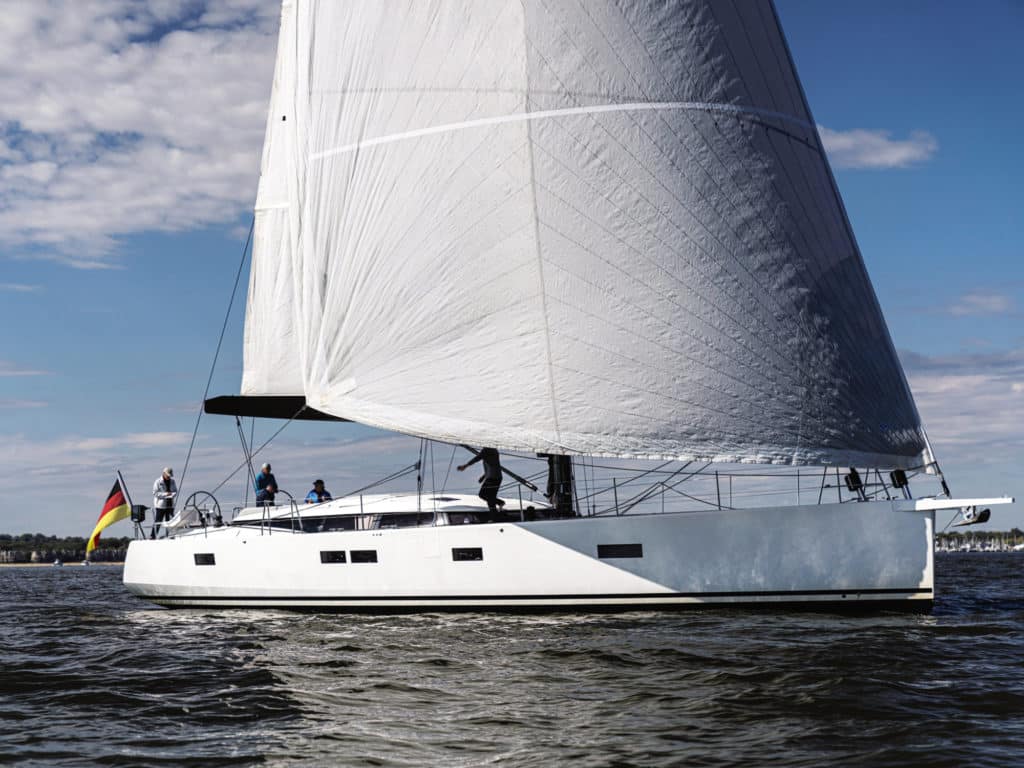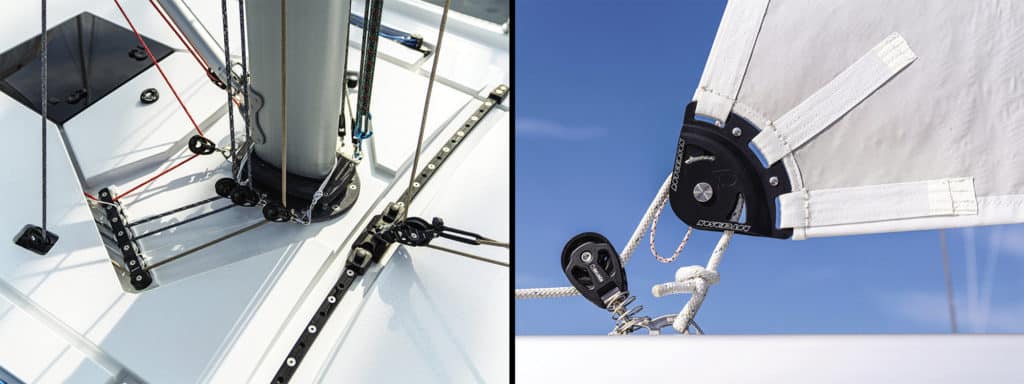
With 25 to 30 sailboats making their North American debut at the United States Sailboat Show in Annapolis, Maryland, each fall, it’s a logical place to look for design trends. Hard chines in the hull, galleys forward in the saloon, and grills and sinks incorporated into the transom are a few recent trends that multiple builders have adopted. But looking at this year’s fleet, what really jumped out at me was the number of boats being designed to fly self-tacking jibs.
By my count, 11 of the 27 new models in the Class of 2022 were rigged with roller-furling, non-overlapping headsails that get sheeted to a car mounted on an athwartships track on the deck, forward of the mast. Typically, the sail’s single sheet is then led to a block-located well up the mast, where it disappears into the spar, runs back down to the deck and, eventually, is led back to a winch, often located on the cabin top.
Add to those boats the majority of the rest of the fleet, which sported headsails measuring less than 110 percent of the foretriangle. Clearly, a revolution has taken place on the pointy end of most modern cruising sailboats.
Relatively modest-size mainsails and big, powerful genoas have been tossed overboard in favor of more horsepower in the main (often furled in the mast for ease of handling) and smaller, easier-to-control headsails that have dramatically reduced the effort needed to sail upwind. For those who haven’t tried, believe me, cranking in a 107 percent or smaller jib in a stiff breeze is a whole lot easier than grinding in the venerable 135 percent (or larger) genoa commonly found on older designs. And the self-tackers, well, once they and the main are sheeted home, coming about requires only a turn of the wheel.
UK Sailmakers International general manager Adam Loory says that there are obvious benefits for a couple or shorthanded crew: “It’s a smaller sail and it can self-tack, so one person on the helm can turn the boat; the jib moves over to the other side, the main moves over to the other side, and the other person can go on reading a book or whatever they were doing.”
But, he adds, “when you trade for the ease of handling a self-tacking jib, you lose all ability to sail on a reach, because on a tall, high-aspect jib, as soon as you ease the sheet, the top of the sail opens up and luffs, plus you don’t have the overlap to bend the wind around to the mainsail. And that’s the whole reason why all the owners of these modern boats are buying code zeros, because you need that sail to reach with.”
So, you ask: What is a code zero, and what happened to the genoas that once ruled supreme on the foredeck?
Well, it all started at the very top of the sport, where racing sails evolved thanks to changing measurement rules, and where equipment-makers are continually developing better sail-handling systems for long ocean races.
While most of us might get by quite well all season with a single headsail, say, a 135 or 150 genoa set on a roller furler, racers tend to favor a quiver of sails that can be swapped out as conditions and points of sail change. Depending on the regatta, they might carry a blade jib for tacking upwind, a close-reaching sail, a deep-reaching sail, storm sails, and probably a spinnaker or two for running. Setting and dousing all these sails is work, so hardware manufacturers came up with new gear that can furl the big billowing sails from the bottom up or, better yet, from the top down. These sails need to be set in front of the furled jib so that they are flown off a bowsprit, and thanks to the furlers, they can be left up when not in use.
In competitive sailing, sailmaking involves finding ways to develop new sails to take advantage of the various handicapping and measurement rules, some of which began to penalize the use of large, overlapping genoas. As a result, a hybrid sail, called the code zero, was designed so it would be measured as a spinnaker but still provide the reaching power of a big genoa. With all the code numbers already taken, this big, flat-cut, light-air reaching sail fell in at the low end—hence the name code zero.
At the same time, the trend toward smaller jibs for racing hard on the wind also meant sheets could be led at tighter angles. Since the sails no longer wrapped around outside the shrouds, the rigging could be moved to outboard chainplates, which lessened compression loads on the mast. That change allowed spars to be built lighter, reducing weight aloft, where it detracts from performance.
It’s worth noting that all of this was happening as builders searched for ways to make sailing simpler and easier, to keep sailors sailing longer, and to attract newcomers to the sport. With electric winches and in-mast and in-boom furling, larger mainsails can be readily tamed. And with smaller headsails, loads are reduced on sheets, which must be frequently trimmed.
The downside is that the minute many contemporary sailboats bear off, even a little, the sailing becomes, well, boring. The small jib quickly loses its oomph.

But fret not. In practical terms, the sails and gear developed to help racers have gone mainstream, and are now incorporated in many of the new production boats that might never see a regatta. The racer’s sprit and cruiser’s anchor bow roller have melded, so adding a furled code zero or cruising chute to, say, a Dufour 470 or Jeanneau Yachts 60 requires only a chat with a sailmaker.
And they, of course, are ready to talk details. Charlie Saville at Quantum Sails in Annapolis says that manufacturers, for the most part, have left the question of additional sails to the buyer. “The OEMs point people to us and say, ‘Talk to your sailmaker because they’ll help you figure out size and material.’”
Quantum offers three versions of its apparent-wind angle reaching sails: the AWA 40 (light air upwind and close reaching), AWA 60 (close and midrange reaching) and AWA 80 (beam to broad reaching).
While a racing skipper with a healthy budget might choose to carry all three because each is optimized for a certain point of sail, most cruisers won’t. That’s where a consultation with the sailmaker comes in. They’ll ask where you intend to sail and what sort of crew you’ll have, and then walk you through the choices.
“If you’re going to have one reaching sail, pick which one you think you’ll be doing the most of, and choose that one,” Saville says.
Loory says that selecting the right reaching sail depends on the boat and how much power is needed for it to sail properly, given the conditions. A code zero for a boat sailing in typically light airs on Chesapeake Bay or the west coast of Florida would be very different than one spec’d out for a sailboat bound for the Caribbean or expecting to sail summers on windy San Francisco Bay.
“That’s why it’s really important that the sailor works with the sailmaker to explain how they’ll use the boat, what kind of boat it is, who’s sailing the boat, and where they’re going with it,” he says.
Cruisers sailing older boats might make out just fine poling out their 135 or 150 percent genoa when sailing dead downwind, but owners of the more-modern designs should also consider carrying a cruising asymmetrical spinnaker, either on a furler or with a dousing sock, if they plan to rely mostly on wind power to get from here to there. Again, Loory says, the chute can be designed for anticipated conditions.
Cost estimates vary depending on the boat, the sailor and the material, but expect to pay in the $4,000 to $5,000 range for a code zero built for a 40-footer. Add another $3,000 and change for a furler and anti-torsion cable.
Gennaker is the name that North Sails uses for its reaching sails, says Will Welles, a sailmaker in the company’s Rhode Island loft. North recently introduced a couple of designs, each built with a structured luff so that a smaller anti-torsion cable can be used. The cable runs between the swivel that’s attached to the halyard and the continuous line furler, and the sail furls around it when not in use.
The Helix Furling Gennaker is intended for light air and tighter wind angles, while the Easy Gennaker is a fuller-cut sail optimized for deeper angles.
The Helix is designed for a wind range from about 5 to 16 knots. The lighter the breeze, the higher you can sail, Welles says. As the wind builds, you can put the bow down and sail deeper. How deep and when to furl or snuff the sail depends on the comfort level of the crew.
The Easy Gennaker covers essentially the same windspeed range but is meant for more broad-reaching conditions. An owner who wants to carry both sails might consider having a swivel and anti-torsion cable for each sail but using the same endless line-furling drum to save a few dollars.
But, he notes, “most cruisers are cruising, out on the water relaxing and enjoying themselves. They typically don’t have a foredeck team, thus one sail that can cover a large range is preferable. They might choose a Helix Gennaker because it’s just a more versatile sail. You can probably get as low as 135 apparent with that sail by easing the halyard. It’s not going to perform as well as the Easy Gennaker at the broader angles because it’s a much flatter shape and it’s a smaller sail in the midgirth, but it’ll work, and it would certainly be better than trying to sail downwind with a self-tacking jib.”
Mark Pillsbury is a CW editor-at-large.
Sail Care
Furling reaching sails, whether called a code zero or gennaker, can be built with ultraviolet protection, though the covering is lighter in weight than the layer of Sunbrella or other material that might be used on a jib or genoa designed to be stowed for long periods of time on a conventional rigid furler. Because the code zeros are intended to be flown in lighter breezes, to avoid sagging, a lighter cover is used, and it’s glued on rather than stitched.
All three sailmakers said that the reaching sails can safely be left up for a weekend or typical short cruise but should be taken down and stowed below when the boat is put away, or if it’s going to be at anchor for any length of time.
In the case of boats with a solent or cutter rig, where a non-overlapping jib is set on the inner forestay and a code zero is furled on a traditional rigid furler on the forward stay, a heavier cover can be applied.
Contact a Sailmaker
- Doyle Sailmakers: 978-740-5950, doylesails.com
- Neil Pryde Sails: 203-375-2626, neilprydesails.com
- North Sails: 401-683-7997, northsails.com
- Quantum Sails: 231-941-1222, quantumsails.com
- UK Sailmakers: 914-600-8800, uksailmakers.com
- Ullman Sails: 27-21-007-3826, ullmansails.com








